TREAT News
DRY SEASON JULY TO SEPTEMBER 2025
IN THIS ISSUE (Items are included in TREAT News for their interest to members and do not necessarily express TREAT's views)
A tale of trees and community at Wetherby Station
COMING EVENT AGM - 5 SEPTEMBER 2025
TREAT’S 43rd Annual General Meeting will be held on Friday 5th September at the Yungaburra Community Hall commencing at 7pm. Annual reports by the President and Treasurer, and the Nursery Manager, will be followed by the election of TREAT office bearers for the next year. Members are reminded that they must be financial when voting for the new committee. Subscriptions will be accepted at the AGM. Following the AGM, a General Meeting is held at which members can raise any issues.
Our guest speaker for the evening will be Dr. John Winter, whose talk is titled ‘Citizen Scientists: skilled volunteers’. Skilled volunteers are an essential component of all environment conservation programs in Far North Queensland and in this talk, John will examine the essential components that make a successful Citizen Science project, using local examples.
The evening concludes with a supper, and food contributions are appreciated. Everyone is welcome to attend the evening.

John Colless sharing his wisdom with Mt Molloy students
A Tale of Trees and Community at Wetherby Station - Océane Dupont (Gulf Savannah NRM)
On April 26th, 1300 trees were planted on Wetherby Station by TREAT and community volunteers. Gulf Savannah NRM initiated the project with the help of John Colless, owner of Wetherby Station, to restore 3 hectares of wetland on the iconic property. It has become a real community effort, with helpful advice from many local experts, including retired botanist and now president of TREAT, John Clarkson. His research paper prompted the use of a new herbicide and innovative drone spraying techniques to control the pesky weed Hymenachne amplexicaulis, while preserving native flora.
Wetlands like the one at Wetherby Station play an essential role in the North Queensland landscape. They regulate water flow by absorbing water during the wet season and slowly releasing it over the dry months, acting like a natural sponge to keep creeks flowing and nature healthy all year-round. Through their key role in groundwater recharge, wetlands from the west side of the Great Dividing Range sustain natural resources, agriculture and important floodplain nurseries for barramundi and prawns in the Gulf of Carpentaria. Riparian vegetation around the wetland filters pollution runoff, reduces erosion and improves water quality, creating ideal habitat conditions for birds and wildlife. More than 120 species of birds have been spotted around Wetherby Station’s lagoons over the years, including eastern cattle-egret, white-bellied sea-eagle and rufous owl.
The project started with a major weed control effort to rid the revegetation area of giant rat's tail grass (Sporobolus sp.) and sicklepod (Senna obtusifolia). Rip lines were cut into the ground to facilitate planting, and 1500 trees were ordered from a local nursery. Seeds were of local provenance and the species adapted to the wetland, with a healthy mix of ‘wet feet’ and ‘dry’ species including Melaleuca quinquenervia, M. leucadendra, M. viridiflora, Lophostemon suaveolens, Eucalyptus cullenii and Ficus superba.
Wetherby Station was bustling with activity during the ANZAC Day long weekend in April, welcoming more than 50 people on the station over two days of planting and mingling. The first day with TREAT volunteers was a great success, with 1100 trees put into the ground in record time. Lunch followed with a well-deserved BBQ and cake to celebrate, put together by John’s wife Kathy and daughter Julia. Another 150 trees were planted that same day by family friends camping on the property.
The next Monday, it was time for the new generation of tree lovers to get involved. 27 children and their parents from Mt Molloy State School, assisted by Gulf Savannah NRM officers Oceane Dupont and Janani Gedara, and Kuku Djungan Murtiki ranger Sheneale Grainer, all came and planted a further 55 trees around the wetland. The children had a great time planting their own trees and enjoyed their morning tea while learning all about cattle farming. The day was hot and sunny, and the trees needed watering afterwards.
Electric pig fencing, maintenance and weed control are now on the way to ensure the best results from the revegetation project. The little trees are also growing well, and the billabong is turning back to being a favourite spot for birds year-round. Gulf Savannah NRM is thankful to TREAT for their expert advice and enthusiastic support, and everyone who spent their time and effort to make this project a success.
** Enhancing wetland conservation values at Wetherby Station is a project led by Gulf Savannah NRM and funded by the Queensland Government's Department of Environment, Science and Innovation through the Community Sustainability Action Grants Program.

TREAT volunteers planting at Wetherby
PLANT PROFILE - MELIA AZEDARACH - Dinah Hansman
Melia azedarach, commonly known as White Cedar, is less known at TREAT because its usefulness to our revegetation plantings is confined to Mabi forest (Regional Ecosystem 7.8.3) and it has a reputation as a weed.
Melia is the type genus for the family Meliaceae. In other words, the family Meliaceae was defined by the characteristics of the genus Melia. Meliaceae, the Mahogany family, includes many sought-after timber species, including the well-known red cedar (Toona ciliata). In the Wet Tropics, Meliaceae has 30 tree and shrub species with the genera Aglaia and Dysoxylum having the most species.
You may have noticed Melia azedarach growing in patches of Mabi Forest along the Gillies Highway north of Yungaburra and also at 40-mile NP. It is especially noticeable in June to August because it is deciduous and retains its yellow bead-like fruit.
M. azedarach is the only native tree that is leafless in the winter. This makes it a useful choice wherever you want summer shade and winter sun. It is widely cultivated in Australia as a garden tree and is used as a street tree in southern Australia. It is very attractive, with feathery foliage and masses of fragrant lilac flowers in spring.
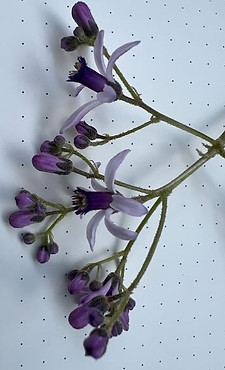
Flowers
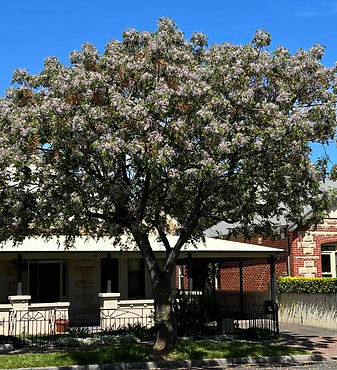
Growing as a street tree in Adelaide

Fruit
M. azedarach is endemic to the east coast of Australia from Cooktown to south-eastern NSW. It is favoured by disturbance and is a pioneer species in drier rainforests and monsoon forests. However, it is naturalised across tropical Australia from the Kimberley and NT to parts of South Australia. It also occurs in Asia, Malesia and Solomon Islands. Like many species with a wide distribution, it tends to be resilient—withstanding frosts and extreme heat, extended dry periods and a range of soil conditions. It also spreads by root suckers. These super-survival skills also give it weedy properties and it is a weed in south-eastern US, the Pacific and NZ. It has become invasive in the Kimberley and NT.
M. azedarach is endemic to the east coast of Australia from Cooktown to south-eastern NSW. It is favoured by disturbance and is a pioneer species in drier rainforests and monsoon forests. However, it is naturalised across tropical Australia from the Kimberley and NT to parts of South Australia. It also occurs in Asia, Malesia and Solomon Islands. Like many species with a wide distribution, it tends to be resilient—withstanding frosts and extreme heat, extended dry periods and a range of soil conditions. It also spreads by root suckers. These super-survival skills also give it weedy properties and it is a weed in south-eastern US, the Pacific and NZ. It has become invasive in the Kimberley and NT.
M. azedarach produces copious fruit which are eagerly dispersed by birds. Fruit are yellow balls about 15 mm long and 10 mm diameter and are retained on the tree for a long time (if not eaten). They are conspicuous because they are displayed in large clusters, ripening while the tree is leafless. The fruit is a drupe, with squishy yellow flesh surrounding a hard ribbed stone 6 mm diam. The seeds are within the hard stone (as in a peach).
Fruit become white then brown as they ripen and the skin becomes wrinkled with a papery outer skin. Collect fruit from the ground or tree. Older brown fruit will germinate more quickly. Note that the plant is poisonous, so wear gloves.
Like many pioneer species, seeds are tricky to germinate in a nursery environment but germinate readily in the wild when dispersed by birds. In the nursery they take 177 to 245 days to germinate. They can be treated like quandongs—dry compost stones until they start to germinate, then spread sparsely over germinating medium. Alternatively, harvest seedlings from the wild.
All parts of the plant are toxic to mammals but various parts of the plant have been used medicinally. Like its relative, the Neem Tree,
M. azedarach can be used as an insecticide.
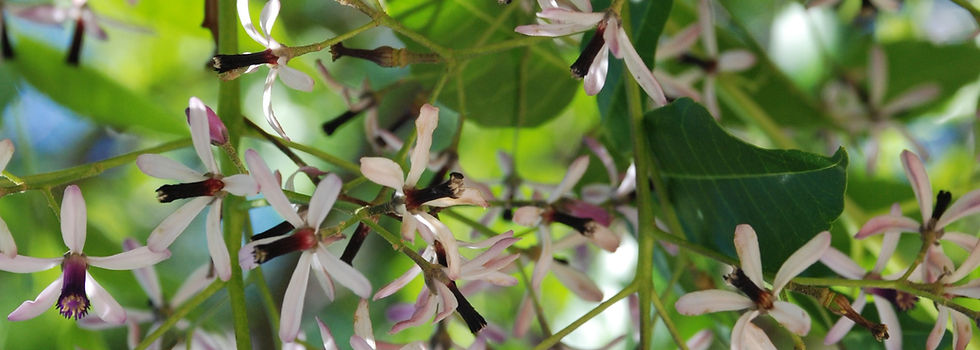
WEED CONTROL OPTIONS - John Clarkson
For some time, on the last Friday of the month, I have been introducing TREAT volunteers to a ‘Weed of the Month’. In the last issue of this newsletter, I gave a definition of what a weed is. Put simply, it is any plant that has or may have an adverse effect on something you think is special. However, you should keep in mind that you have what is known as the General Biosecurity Obligation (GBO). This means not growing something that could spread and impact on the things viewed as special to others. Having defined a weed, what are we to do about them? Basically, there are four options – prevention, eradication, containment and reduction of impacts. The four options are often depicted graphically in what weed scientists refer to as the ‘Invasion Curve’.
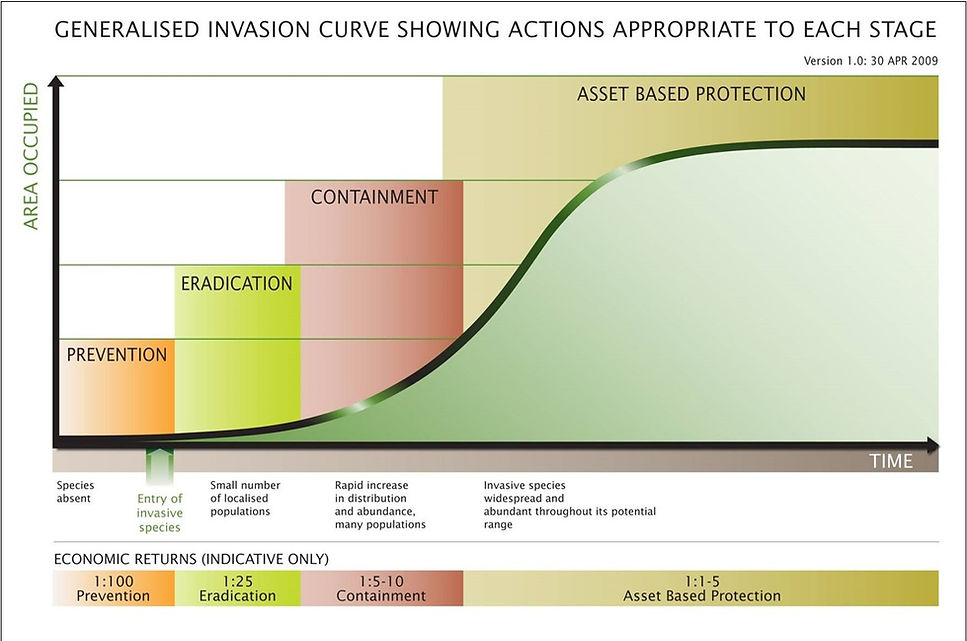
Many factors such as the original source of the plant, its biology, dispersal processes and pathways, seed longevity and potential for reinvasion must be considered before an informed judgement can be made regarding which strategy should be adopted. Deciding to ‘do nothing’ can be a valid response to dealing with some weeds in certain situations.
Because of the significant costs and practical difficulties in dealing with invasive species, prevention, which aims to exclude species from an un-invaded region, is more cost effective and environmentally desirable than actions taken after invasion. As a result, a range of pre- and post-border weed risk assessment systems (WRA) has been developed. Pre-border WRA systems can inform quarantine authorities whether species should be permitted or denied entry to particular jurisdictions. Post-border systems are useful in identifying high risk species but must be supported by other management strategies within the species’ invaded range if they are to be effective.
Eradication is a management strategy that has considerable appeal and one which has been discussed widely in the literature. It is sometimes wrongly equated to killing or removing individuals at one point in time with little or no consideration given to the consequences of new individuals arising from the soil seed bank or other reserves of propagules (e.g. corms, bulbs, aerial tubers etc.) or the reintroduction of propagules from outside the area treated. Eradication can be attempted at many scales, from a single property to nation-wide. The term ‘extirpation’ is sometimes used to denote local, as opposed to global, elimination of a species, although ‘local eradication’ may be more readily understood by land managers and weed control practitioners.
Containment has been used to refer to a management strategy that aims to either prevent spread of invasive species from an invaded region; exclude species from an uninvaded region; ‘slow-the-spread’ of an invasive species; provide an interim response during which decisions are made regarding the costs and benefits of eradication, control or no management; or prevent commercially useful species from spreading outside areas where they are intentionally cultivated. It is often presented as a ‘fall-back’ position when eradication is deemed not feasible although recent studies have shown that often this cannot be justified.
Weed species that are widespread are unlikely to be amenable to eradication or containment. For these species, it may be necessary to concentrate efforts on reducing impacts to protect certain assets. Assets however, can be defined in many ways and something prized and highly valued by one sector may not be accepted as such by another. Unlike crop yield and livestock production which can be measured in economic terms, the value of healthy landscapes, biodiversity and cultural assets is less easily quantified and, although attempts are being made to value these resources, the final decisions concerning this are inevitably socio-political and embedded within a particular cultural context. Success of this strategy must be measured in terms of outcomes not inputs and desired thresholds should be set before on-ground management commences.
It is impossible to do everything everywhere and any attempt to do so inevitably results in nothing being done very well anywhere. To do nothing is an option which should be considered for certain species in particular situations. In some instances, the impact of the species may not warrant action; in others, resources may be limited and other species may demand priority. However, it is imperative that the decision to do nothing is based on all available data including information on the biology of the species, its dispersal characteristics and its potential impacts across relevant land uses. It is important that the consequences of doing nothing are well understood and accepted; that periodic review is undertaken to detect any changes in impact and distribution; and there is a willingness to reconsider the original decision if monitoring shows conditions have changed. This could be described as watchful waiting. It is not a totally passive response and demands a small share of available resources.
This is an abridged version of a paper presented at the 12th Queensland Weed Symposium held in Hervey Bay in 2013 by John Clarkson and the late Tony Grice of CSIRO. A copy of the paper has been lodged in the TREAT library.
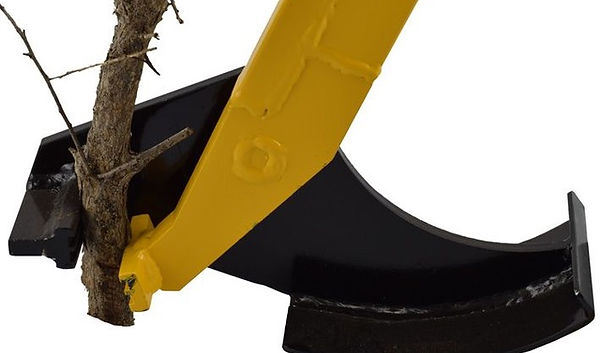
Tree Popper engaging with the trunk of a woody weed
TREAT Loan Equipment - John Hardman
For many years, TREAT has provided trees to members for planting on their own properties. This allocation has numbered from 10 up to 300 trees per year, and over the years, thousands of trees have been planted by our dedicated volunteers.
To make this task easier, TREAT has purchased equipment for loan to members.
Specifically, we have two Stihl petrol powered Augers to enable holes to be dug quickly, and these machines are provided free of charge. They are serviced annually and are generally replaced after about seven years of operation.
With the advances in battery technology, I would not be surprised to see electric augers soon.
In recent times we have looked at other pieces of equipment to assist our members to not only plant trees but to prepare and maintain planting sites. To this end we purchased three Tree Poppers as a trial to allow members to efficiently remove woody weeds from their planting sites without the use of chemical spraying.
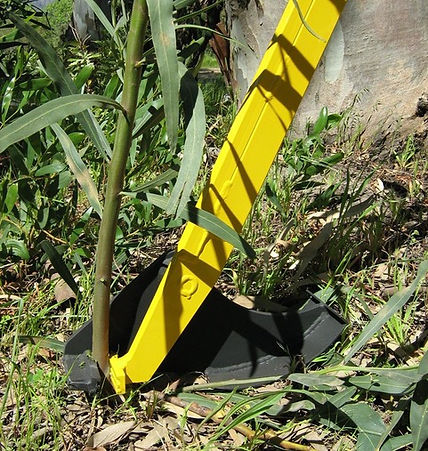
Tree Popper in action
These mechanical devices allow the user to firmly grip a woody weed near the base and with a simple levering action, remove the weed, roots and all. They are of robust construction and should give Many years of service.
-
The Large Tree Poppers can remove woody weeds up to 50 mm and weighs 7.5 kg.
-
The Medium Tree Popper can remove woody weeds up to 30 mm and weighs 5.5 kg.
-
The Small Tree Popper can remove woody weeds up to 20 mm and weighs 3.0 kg.
All of these Tree Poppers have a mechanical advantage of about 10 times the weight applied to the lever.

Brachychiton seedlings
My Friday Mornings at TREAT - Barb Lanskey
People come to TREAT for different reasons. I first came to TREAT back in March 1999 when I wanted to plant some trees as shade for cattle. We had no trees on the grazing pasture block where we now lived, close the Atherton, and I was told by the lass where we bought our stock feed, that TREAT would be able to advise me. I had an old school friend visiting some time later, so with her for moral support, I eventually went out to TREAT one Friday morning.
We were made very welcome and shown how to pot up seedlings. The nursery manager at the time, Nigel Tucker, said they had plenty of trees in stock for planting where I lived. My friend went home, and the next Friday I went to the nursery on my own. I’ve been coming ever since.
I knew nothing about how TREAT and QPWS worked together, but was happy to soak up information and keen to learn about all things natural - I’d grown up on a farm but at school there were no botany or biology classes. Joan Wright was in charge of the TREAT side of things, and at one time she gave a series of botany lessons on a Friday. At the end of the year, a workshop was held at the nursery about identifying trees from leaves and propagating seeds. I started learning botanical names. There were field days to places where trees had been planted and I was encouraged to draw up a plan for planting trees at my place. My first trees (about 250) were planted by QPWS in February 2000. Then I started caring for the trees, and preparing for the planned planting the next year.
After being at TREAT a couple of years, attending everything I could and taking part in a video about planting, I was asked to join the TREAT management committee (as president!), and was eventually convinced to do so. After a while, Joan faded from Friday mornings and I took over the ‘chat’ she used to do at morning tea time. Joan got everyone’s attention by banging on one of the posts. I couldn’t bang the way she did, so brought a bell from the farm and put that up to ring instead. I also stood on the stairs to get a better view of the volunteers as I spoke. The bell ringing continues today.
In 2000, Nigel and the other staff worked at desks in the now TREAT office and kitchen, and it was all quite crowded. Because of the nursery’s increasing expertise and services, including student training and research work, the name of the nursery was changed to ‘Centre for Tropical Restoration’ and expansion of the buildings and outside area was planned. In 2003, the QPWS offices were in the new building and the TREAT Display Centre was opened. Friday mornings upstairs became less crowded.
In those years, there was a core of about 30 volunteers who came to Friday mornings on a regular basis. Occasionally the numbers would be swelled by students from SFS (School for Field studies), SIT (School for International Training) or Japan, and by others who had moved to the area and wanted to plant trees on their property.
Angela took over as president in 2011 and the number of people coming on a Friday increased. Gradually the socialising part of TREAT attracted a number of people who felt they could contribute by sitting down doing seed-cleaning or bringing food for morning tea. This food spread is now a feast to behold, compared to earlier days when only a few volunteers contributed food. Since Sandra has organised teams for morning tea duties, these teams seem to try to outdo each other with their cooking - and other volunteers still bring food as well.
A big change has been in the number of QPWS staff. When I first arrived, Peter Snodgrass was part of the large staff, but gradually other staff went their separate ways. An MOU (memorandum of understanding) was signed by TREAT and QPWS in 2004 to give some formality to the relationship and the latest MOU was signed in 2023. With recent staff absences, TREAT volunteers (with appropriate expertise) and indigenous rangers have stepped up to help with some of the staff jobs, such as seed collecting.
In 2002, Syb Bresolin and Warren Canendo were training in horticultural certificates at the nursery, and then became trainers themselves in Cross-Cultural Awareness programs. I vividly remember Syb talking to the volunteers one Friday about cultural law/lore. Now, various indigenous ranger groups regularly come to help, with nursery work on Fridays and often during the week, and in the field. Another group who have become regulars, are the VPG (Volunteer Partnership Groups) trainees. Their leader has been a great influence in helping with TREAT and nursery work as part of their training. When I arrive at Friday mornings these days, I’m not at all surprised to see up to 60 people.
John Clarkson took over as president from Angela in 2024 and has his own version of the ‘chat’ on Friday mornings. I can just listen and hear the latest - it’s such a pleasure to come.
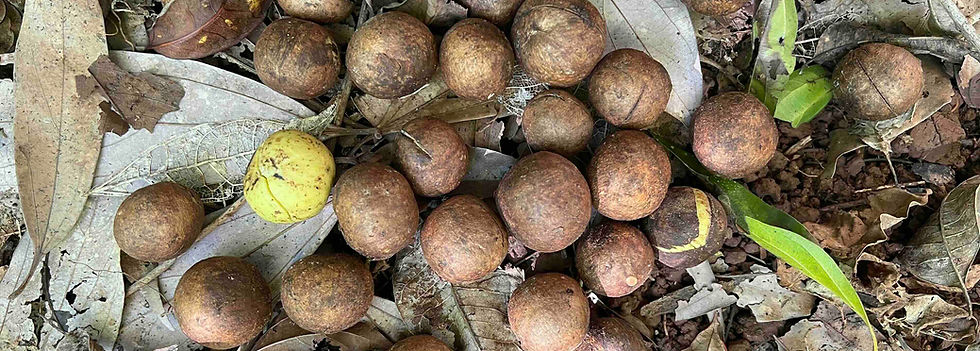
Syzygium alliiligneum
Seed Collecting with Anthony - Alan Gillanders
From early June I’ve signed up as a National Park Volunteer to spend a day at a time, collecting seeds with Anthony, currently in charge at the Lake Eacham nursery. This has been a most enjoyable experience.
Usually we meet at the nursery with the timing depending on where we are going and other tasks Anthony must fulfill. If passing a café it is not unusual to purchase a coffee or hot chocolate to set the day up right. While we’ve been as far afield as the Malaan and Innisfail, other trips are closer to home.
Our eyes are kept peeled as we drive or walk along areas of vegetation which could provide resources. Technology aids in this endeavour, as previous collections have been entered onto the GPS which is run in the vehicle. When new seed sources are found, they are entered into the record with a phenology score. This is not a skull measurement (phrenology) but a record of the developmental stage of the flowering or fruiting. This will enable us to return at an appropriate time to hopefully collect fruit. A written record is made of all fruit collections as well. The objective is to propagate plants from the ecosystems most similar to where they will later be planted, and this provides us with an incentive (excuse) to travel to interesting spots.
Recently, after we delivered a thousand plants from the nursery for a Eubenangee Swamp NP planting, Anthony and I were able to collect fruit from an old planting there. It was inspiring to walk through a forest I helped to plant, and see not only established trees but epiphytes and vines giving a feeling of a mature forest. Some of our collection will be sown at the nursery but some was given to Doug, the local ranger, for direct seeding.
The benefit for me other than the ‘feel good’ factor of furthering our revegetation work and spending time in the bush with good company, is refreshing and extending my botanical knowledge. So often I’m confronted with a plant and react “I used to know that species”. At other times the reaction is “I’ve got absolutely no idea”. The ‘Australian Tropical Rainforest Plants’ app key on our phones is our prime identification resource in the field, and then if needed, checks are made at home or the nursery. Ripe fruit are picked from the trees sometimes by hand but more often with a long-handled picker. Others like Black Bean and Onionwood are collected from the ground where they have fallen.
Our lunch spots have been additional bonuses: from sitting on a seat made from a pallet at Bramston Beach, to standing by the vehicle on top of a high ridge off Beatrice Way.

A Sneaky Dispersal Strategy of Onionwood, SYZYGIUM ALLIILIGNEUM - Alan Gillanders
It has long been noted that Onionwood is a shy setter of seeds, but our observations may be at fault too. This season I noticed that the larger and later fruit had a much higher ratio of seed set than the smaller and earlier dropped fruit. In the past I’ve given up on trees where there were few or sometimes no seeds in the early fruit.
I’m beginning to believe that this might be a sneaky strategy to ‘capture’ a long distance dispersal agent, namely a Cassowary, without wasteful energy expenditure. These birds are long-distance dispersers of large fruited rainforest plant species. Smelling of minerals and onions, the large red fruit do not seem highly attractive to mammals such as possums and rats which rely on scent to find a meal.
It makes sense for a plant to drop fruit which have not been pollinated, as a fruit is merely the means to spread a seed containing the plant’s genes. However, why set fruit at all if not pollinated? Or at least, why not drop it very early in the fruiting phase to save energy?
For a plant dependent on an infrequent visitor, it is advisable to have enduring fruit or fruit which ripens over a long period to increase the likelihood of fruiting overlapping with the arrival of the desired dispersal agent. By having a long period where little is invested in the production of seeds, the chance of ‘capturing’ this agent is increased. Cassowaries are not silly and once they are on to a good thing they’ll revisit that site. If the seed bearing fruit are produced towards the end of the fruiting cycle there is more chance that a bird will be on hand to spread the fruit and hence the plant’s genes, far and wide.
Not only is this a very attractive tree but it may be a ‘smart’ one too!
Germinating Candlenut
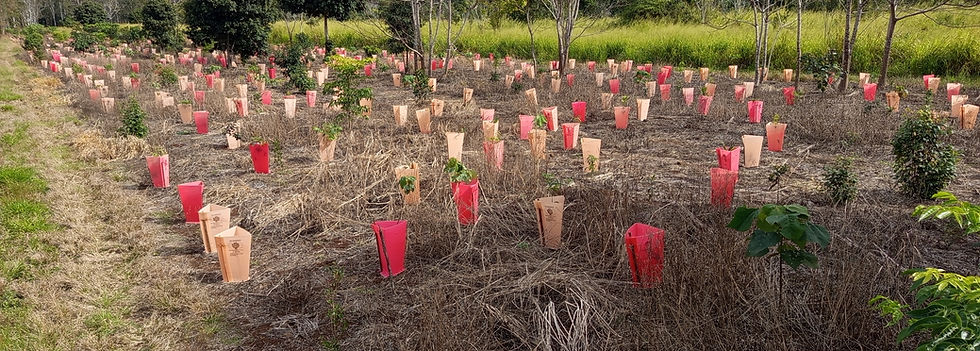
NURSERY NEWS - Anthony Lincy
I was initially somewhat overwhelmed when Peter Snodgrass departed on leave. However, as I began to find my footing, I was fortunate to be approached by several knowledgeable volunteers who generously offered their time and support.
Now, with the assistance of Dinah Hansman, Alan Gillanders, Jim Fitzgerald, Des Rumble, the Vocational Partnerships Groups team, the Ngadjon-jii Rangers and many more, I have established a weekly routine that makes the work schedule more manageable, resulting in significant progress each Friday.
Some highlights from the past three months:
Nursery
* Dinah Hansman has been instrumental in data collection and tag replacement around the nursery, and she has also dedicated some weekdays to share her expertise with germination, cuttings and general nursery management.
* Alan Gillanders and Jim Fitzgerald have consistently contributed to seed collecting on a weekly basis.
* The Vocational Partnerships Groups team and the Ngadjon-jii Rangers from the Choorechillum Aboriginal Corporation, have assisted with seed collecting, sowing, weeding and general nursery maintenance.
Wongabel
* On May 24th, TREAT volunteers installed over 1,000 frost guards around frost-sensitive species at Wongabel. Dinah helped in identifying the sensitive species.
* The Vocational Partnerships Groups team helped QPWS Tinaroo Management Unit with successful weed control efforts.
Wooroonooran NP
* The Jawajawa Rangers from the Dulabed & Malanbarra Yidinji Aboriginal Corporation, provided valuable assistance to QPWS with post-planting maintenance and infill at Wooroonooran National Park.
* QPWS and the Jawajawa Rangers are currently planning a 12 hectares planting project at Wooroonooran National Park.
Eubenangee Swamp NP
* QPWS Rangers from the Josephine Falls Management Unit have prepared the next planting site at Eubenangee Swamp National Park and are collaborating closely with the Restoration Services Unit.
I extend my heartfelt gratitude to the TREAT volunteers, the Ngadjon-jii Rangers, the Jawajawa Rangers, and the Vocational Partnerships Groups team for their unwavering support, dedication, and enthusiasm. I feel incredibly fortunate to be surrounded by such remarkable and supportive people.
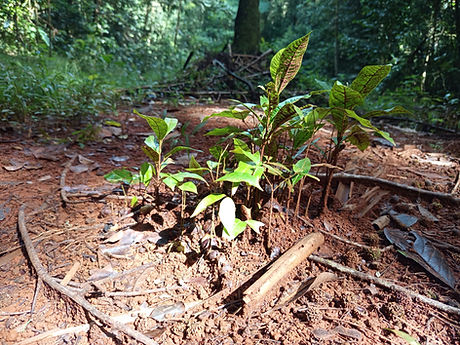
After clearing the lantana and raspberry with the Jawajawa Rangers, at Wooroonooran National Park, the local cassowary was ahead of us with the propagation work.
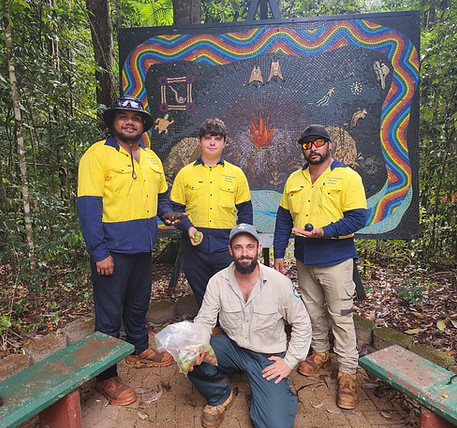
Collecting seed with Ngadjon-jii Rangers at Malanda Falls

FRUIT COLLECTION DIARY April to June 2025
Species | Common Name | Regional Ecosystem | Collection Date |
|---|---|---|---|
Acronychia acidula | Lemon Aspen | 7.8.2, 7.8.3 | 11/06/, 26/06/2025 |
Acronychia crassipetala | Crater Aspen | 7.8.2 | 30/5/2025 |
Aleurites rockinghamensis | Candlenut | 7.8.3 | 26/6/2025 |
Alphitonia petriei | Sarsaparilla | 7.8.2, 7.8.4 | 28/05, 29/05/2025 |
Alphitonia whitei | Red Ash | 7.8.2, 7.8.4 | 12/04, 29/05/2025 |
Alpinia caerulea | Native Ginger | 7.8.3 | 26/6/2025 |
Breynia stipitata | Fart Bush | 7.8.2, 7.8.4 | 12/06, 19/06/2025 |
Castanospermum australe | Black Bean | 7.8.1, 7.8.3 | 16/04, 26/06/2025 |
Clerodendron costatum | Witches Tongues | 7.8.1 | 10/04, 16/04/2025 |
Cordyline fruticosa | Broad Leaved Palm Lily | 7.8.2 | 6/5/2025 |
Cordyline manners-suttoniae | Giant Palm Lily | 7.8.2 | 6/5/2025 |
Emmenosperma alphitonioides | Mountain Ash | 7.8.4, 7.8.2 | 29/05, 12/06/2025 |
Eumachia frutescens | Turkey Bush | 7.8.3 | 26/6/2025 |
Ficus copiosa | Plentiful Fig | 7.8.2 | 28/5/2025 |
Ficus obliqua | Small Leaved Fig | 7.8.2 | 6/5/2025 |
Ficus racemosa | Cluster Fig | 7.8.1 | 11/4/2025 |
Glochidion hylandii | Buttonwood | 7.8.2 | 6/5/2025 |
Homalanthus novoguineensis | Bleeding Heart | 7.8.3, 7.8.4 | 7/4/2025 |
Linospadix minor | Walking Stick Palm | 7.3.10 | 21/4/2025 |
Mackinlaya macrosciadea | Blue Umbrella | 7.8.3 | 21/5/2025 |
Mallotus mollissimus | Kamala | 7.8.2 | 6/05, 03/06/2025 |
Mallotus paniculatus | Turn In The Wind | 7.8.2 | 6/5/2025 |
Mallotus philippensis | Red Kamala | 7.8.3 | 26/6/2025 |
Melia azedarach | White Cedar | 7.8.3 | 26/6/2025 |
Melicope broadbentiana | Euodia | 7.8.2 | 30/5/2025 |
Melicope elleryana | Corkwood | 7.8.1, 7.8.2, 7.8.3 | 9/04, 21/05, 03/06/2025 |
Melicope jonesii | Evodia | 7.8.2 | 21/5/2025 |
Melicope vitiflora | Leatherwood | 7.8.2 | 21/5/2025 |
Melicope xanthoxyloides | Yellow Evodia | 7.8.2, 7.8.4 | 11/06, 19/06/2025 |
Neolitsea dealbata | White Bollywood | 7.8.2, 7.8.4 | 21/05, 19/06/2025 |
Pittosporum venulosum | Rusty Pittosporum | 7.8.4, 7.8.3, 7.8.2 | 29/05, 06/06, 12/06/2025 |
Prumnopitys amara | Black Pine | 7.8.4 | 29/5/2025 |
Pullea stutzeri | Hard Alder | 7.8.2 | 21/5/2025 |
Rhus taitensis | Sumac | 7.3.10 | 21/4/2025 |
Schizomeria whitei | Crabapple | 7.8.3 | 12/6/2025 |
Syzygium gustavioides | Watergum | 7.8.2, 7.8.4 | 28/05, 19/06/2025 |
Syzygium smithii | Satinash | 7.8.4, 7.8.2 | 19/05, 12/06/2025 |
Zanthoxylum ovalifolium | Thorny Yellowwood | 7.8.2 | 12/6/2025 |
Species and Common names taken from 'Australian Tropical Rainforest Plants Edition 8' online key:
